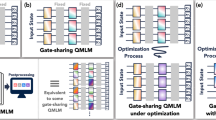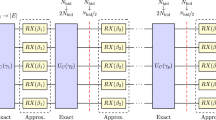Abstract
A promising route towards the demonstration of near-term quantum advantage (or supremacy) over classical systems relies on running tailored quantum algorithms on noisy intermediate-scale quantum machines. These algorithms typically involve sampling from probability distributions that—under plausible complexity-theoretic conjectures—cannot be efficiently generated classically. Rather than determining the computational features of output states produced by a given physical system, we investigate what features of the generating system can be efficiently learnt given direct access to an output state. To tackle this question, here we introduce the variational quantum unsampling protocol, a nonlinear quantum neural network approach for verification and inference of near-term quantum circuit outputs. In our approach, one can variationally train a quantum operation to unravel the action of an unknown unitary on a known input state, essentially learning the inverse of the black-box quantum dynamics. While the principle of our approach is platform independent, its implementation will depend on the unique architecture of a specific quantum processor. We experimentally demonstrate the variational quantum unsampling protocol on a quantum photonic processor. Alongside quantum verification, our protocol has broad applications, including optimal quantum measurement and tomography, quantum sensing and imaging, and ansatz validation.
This is a preview of subscription content, access via your institution
Access options
Access Nature and 54 other Nature Portfolio journals
Get Nature+, our best-value online-access subscription
$29.99 / 30 days
cancel any time
Subscribe to this journal
Receive 12 print issues and online access
$209.00 per year
only $17.42 per issue
Buy this article
- Purchase on Springer Link
- Instant access to full article PDF
Prices may be subject to local taxes which are calculated during checkout




Similar content being viewed by others
Data availability
The datasets generated during and or analysed during the current study are available from the corresponding author on reasonable request.
Change history
04 February 2020
A Correction to this paper has been published: https://doi.org/10.1038/s41567-020-0818-8
References
Nielsen, M. & Chuang, I. Quantum Computation and Quantum Information (Cambridge Univ. Press, 2010).
Montanaro, A. Quantum algorithms: an overview. npj Quantum Inf. 2, 15023 (2016).
Barends, R. et al. Superconducting quantum circuits at the surface code threshold for fault tolerance. Nature 508, 500–503 (2014).
Gaebler, J. P. et al. High-fidelity universal gate set for 9Be+ ion qubits. Phys. Rev. Lett. 117, 060505 (2016).
Fowler, A. G., Mariantoni, M., Martinis, J. M. & Cleland, A. N. Surface codes: towards practical large-scale quantum computation. Phys. Rev. A 86, 032324 (2012).
Mohseni, M. et al. Commercialize quantum technologies in five years. Nature 543, 171–174 (2017).
Preskill, J. Quantum computing in the NISQ era and beyond. Quantum 2, 79 (2018).
Harrow, A. W. & Montanaro, A. Quantum computational supremacy. Nature 549, 203–209 (2017).
Farhi, E., Goldstone, J. & Gutmann, S. A quantum approximate optimization algorithm. Preprint at http://arXiv.org/abs/1411.4028v1 (2014).
McClean, J. R., Romero, J., Babbush, R. & Aspuru-Guzik, A. The theory of variational hybrid quantum-classical algorithms. New J. Phys. 18, 023023 (2016).
Romero, J., Olson, J. P. & Aspuru-Guzik, A. Quantum autoencoders for efficient compression of quantum data. Quantum Sci. Technol. 2, 045001 (2017).
Farhi, E. & Neven, H. Classification with quantum neural networks on near term processors. Preprint at http://arXiv.org/abs/1802.06002v1 (2018).
Schuld, M., Bocharov, A., Svore, K. & Wiebe, N. Circuit-centric quantum classifiers. Preprint at http://arXiv.org/abs/1804.00633 (2018).
Chen, H., Wossnig, L., Severini, S., Neven, H. & Mohseni, M. Universal discriminative quantum neural networks. Preprint at http://arXiv.org/abs/1805.08654v1 (2018).
Steinbrecher, G. R., Olson, J. P., Englund, D. & Carolan, J. Quantum optical neural networks. npj Quantum Inf. 5, 60 (2019).
Aaronson, S. & Arkhipov, A. The computational complexity of linear optics. In Proc. 43rd Annual ACM Symposium on Theory of Computing 333–342 (ACM, 2011).
Bouland, A., Fefferman, B., Nirkhe, C. & Vazirani, U. On the complexity and verification of quantum random circuit sampling. Nat. Phys. 15, 159–163 (2019).
Boixo, S. et al. Characterizing quantum supremacy in near-term devices. Nat. Phys. 14, 595–600 (2018).
Neville, A. et al. Classical boson sampling algorithms with superior performance to near-term experiments. Nat. Phys. 13, 1153–1157 (2017).
Zhang, J. et al. Observation of a many-body dynamical phase transition with a 53-qubit quantum simulator. Nature 551, 601–604 (2017).
Bernien, H. et al. Probing many-body dynamics on a 51-atom quantum simulator. Nature 551, 579–584 (2017).
Arute, F. et al. Quantum supremacy using a programmable superconducting processor. Nature 574, 505–510 (2019).
Shor, P. W. Algorithms for quantum computation: discrete logarithms and factoring. In Proc. 35th Annual Symposium on Foundations of Computer Science 124–134 (Society for Industrial and Applied Mathematics, 1994).
Hangleiter, D., Kliesch, M., Eisert, J. & Gogolin, C. Sample complexity of device-independently certified ‘quantum supremacy’. Phys. Rev. Lett. 122, 210502 (2019).
Carolan, J. et al. On the experimental verification of quantum complexity in linear optics. Nat. Photon. 8, 621–626 (2014).
Mohseni, M., Rezakhani, A. T. & Lidar, D. A. Quantum-process tomography: resource analysis of different strategies. Phys. Rev. A 77, 032322 (2008).
O’Donnell, R. & Wright, J. Efficient quantum tomography. In Proc. 48th Annual ACM Symposium on Theory of Computing 899–912 (ACM, 2016).
Cramer, M. et al. Efficient quantum state tomography. Nat. Commun. 1, 149 (2010).
Cong, I., Choi, S. & Lukin, M. D. Quantum convolutional neural networks. Nat. Phys. https://doi.org/10.1038/s41567-019-0648-8 (2019).
Grant, E. et al. Hierarchical quantum classifiers. npj Quantum Inf. 4, 65 (2018).
Kokail, C. et al. Self-verifying variational quantum simulation of lattice models. Nature 569, 355–660 (2019).
McClean, J. R., Boixo, S., Smelyanskiy, V. N., Babbush, R. & Neven, H. Barren plateaus in quantum neural network training landscapes. Nat. Commun. 9, 4812 (2018).
Grant, E., Wossnig, L., Ostaszewski, M. & Benedetti, M. An initialization strategy for addressing barren plateaus in parametrized quantum circuits. Preprint at http://arXiv.org/abs/1903.05076 (2019).
Eldan, R. & Shamir, O. The power of depth for feedforward neural networks. In Proc. Conference on Learning Theory (eds Feldman, V., Rakhlin, A. & Shamir, O.) 907–940 (JMLR, 2016).
Arora, S., Cohen, N. & Hazan, E. E. On the optimization of deep networks: implicit acceleration by overparameterization. In Proc. 35th International Conference on Machine Learning, ICML 2018 (eds Dy., J & Krause, A.) 372–389 (International Machine Learning Society, 2018).
Bengio, Y., Lamblin, P., Popovic, D. & Larochelle, H. Greedy layer-wise training of deep networks. In Advances in Neural Information Processing 19 (eds Schölkopf, B., Platt, J. C. & Hoffman, T.) 153–160 (MIT Press, 2007).
Hettinger, C. et al. Forward thinking: building and training neural networks one layer at a time. Preprint at http://arXiv.org/abs/1706.02480v1 (2017).
Barenco, A. et al. Elementary gates for quantum computation. Phys. Rev. A 52, 3457–3467 (1995).
Mitarai, K., Negoro, M., Kitagawa, M. & Fujii, K. Quantum circuit learning. Phys. Rev. A 98, 032309 (2018).
Khatri, S. et al. Quantum-assisted quantum compiling. Quantum 3, 140 (2019).
Romero, J. et al. Strategies for quantum computing molecular energies using the unitary coupled cluster ansatz. Quantum Sci. Technol. 4, 014008 (2018).
Grimsley, H. R., Economou, S. E., Barnes, E. & Mayhall, N. J. An adaptive variational algorithm for exact molecular simulations on a quantum computer. Nat. Commun. 10, 3007 (2019).
Scheel, S. Permanents in linear optical networks. Preprint at http://arXiv.org/abs/quant-ph/0406127 (2004).
Valiant, L. G. The complexity of computing the permanent. Theor. Comput. Sci. 8, 189–201 (1979).
Reck, M., Zeilinger, A., Bernstein, H. J. & Bertani, H. Experimental realization of any discrete unitary operator. Phys. Rev. Lett. 73, 58–61 (1994).
Rahimi-Keshari, S. et al. Direct characterization of linear-optical networks. Opt. Exp. 21, 13450–13459 (2013).
Laing, A. & O’Brien, J. L. Super-stable tomography of any linear optical device. Preprint at http://arXiv.org/abs/1208.2868 (2012).
Rubin, N. C., Babbush, R. & McClean, J. Application of fermionic marginal constraints to hybrid quantum algorithms. New J. Phys. 20, 053020 (2018).
Russell, N. J., Chakhmakhchyan, L., O’Brien, J. L. & Laing, A. Direct dialling of Haar random unitary matrices. New J. Phys. 19, 033007 (2017).
Notaros, J. et al. Ultra-efficient CMOS fiber-to-chip grating couplers. In Proc. Optical Fiber Communication Conference M2I–M25 (2016).
Silverstone, J. W. et al. On-chip quantum interference between silicon photon-pair sources. Nat. Photon. 8, 104–108 (2014).
Carolan, J. et al. Scalable feedback control of single photon sources for photonic quantum technologies. Optica 6, 335–340 (2019).
Najafi, F. et al. On-chip detection of non-classical light by scalable integration of single-photon detectors. Nat. Commun. 6, 5873 (2015).
Brinks, D. et al. Visualizing and controlling vibrational wave packets of single molecules. Nature 465, 905–908 (2010).
Guha, S. et al. Quantum enigma machines and the locking capacity of a quantum channel. Phys. Rev. X 4, 011016 (2014).
Guha, S. Structured optical receivers to attain superadditive capacity and the holevo limit. Phys. Rev. Lett. 106, 240502 (2011).
Niu, M. Y., Chuang, I. L. & Shapiro, J. H. Hardware-efficient bosonic quantum error-correcting codes based on symmetry operators. Phys. Rev. A 97, 032323 (2018).
Moroder, T. et al. Certifying systematic errors in quantum experiments. Phys. Rev. Lett. 110, 180401 (2013).
Powell, M. J. The bobyqa algorithm for bound constrained optimization without derivatives (2009).
Johnson, S. G. The NLopt nonlinear-optimization package (2011); http://ab-initio.mit.edu/nlopt
Chen, C. et al. Efficient generation and characterization of spectrally factorable biphotons. Opt. Exp. 25, 7300–7313 (2017).
Carolan, J. et al. Universal linear optics. Science 349, 711–716 (2015).
Harris, N. C. et al. Quantum transport simulations in a programmable nanophotonic processor. Nat. Photon. 11, 447–452 (2017).
Harris, N. C. et al. Linear programmable nanophotonic processors. Optica 5, 1623–1631 (2018).
Acknowledgements
We thank E. Farhi, E. Grant, D. Hangleiter, I. Marvian, J. McClean, M. Pant, M. Schuld, P. Shadbolt, S. Sim and G. Steinbrecher for insightful discussions. This work was supported by the AFOSR MURI for Optimal Measurements for Scalable Quantum Technologies (FA9550-14-1-0052), the MITRE Quantum Moonshot Program and by the AFOSR programme FA9550-16-1-0391, supervised by G. Pomrenke. J.C. is supported by EU H2020 Marie Sklodowska-Curie grant number 751016.
Author information
Authors and Affiliations
Contributions
J.C., M.M., S.L. and D.E. conceived the project. J.C., M.M., J.P.O., M.Y.N, S.L. and D.E. developed the theory. J.C., M.P., C.C., D.B., N.C.H., F.N.C.W., M.H. and D.E. contributed to the experimental set-up. J.C., M.P., C.C. and D.B. performed the experiment and analysed data. J.C. performed numerical experiments. All authors contributed to the discussion of the results and the writing of the manuscript.
Corresponding author
Ethics declarations
Competing interests
The authors declare no competing interests.
Additional information
Peer review information Nature Physics thanks Ashley Montanaro and the other, anonymous, reviewer(s) for their contribution to the peer review of this work.
Publisher’s note Springer Nature remains neutral with regard to jurisdictional claims in published maps and institutional affiliations.
Supplementary information
Supplementary Information
Supplementary Figs. 1–4 and Sections I–V.
Rights and permissions
About this article
Cite this article
Carolan, J., Mohseni, M., Olson, J.P. et al. Variational quantum unsampling on a quantum photonic processor. Nat. Phys. 16, 322–327 (2020). https://doi.org/10.1038/s41567-019-0747-6
Received:
Accepted:
Published:
Issue Date:
DOI: https://doi.org/10.1038/s41567-019-0747-6
This article is cited by
-
Learning quantum systems
Nature Reviews Physics (2023)
-
Variational quantum state eigensolver
npj Quantum Information (2022)
-
Variational quantum algorithms
Nature Reviews Physics (2021)
-
The potential and global outlook of integrated photonics for quantum technologies
Nature Reviews Physics (2021)
-
High-performance quantum entanglement generation via cascaded second-order nonlinear processes
npj Quantum Information (2021)



